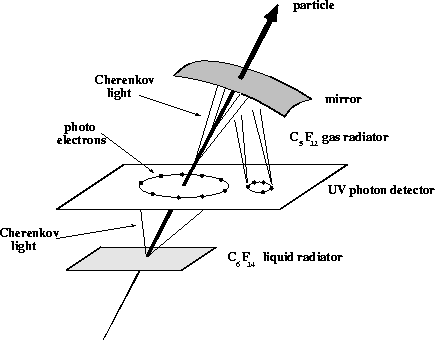Physics:Ring imaging cherenkov counter
A large-acceptance detector using photons from Cherenkov radiation for a measurement of the particle velocity ![]() . Particles pass through a radiator, the radiated photons may be directly collected by (or are focused by a mirror onto) a position-sensitive photon detector. Respectively, these are called direct focusing or mirror-focused RICH detectors. For direct focusing, radiators have to be kept thin (e.g. a liquid radiator), to avoid broadening the ring or filling it; however, Fabjan95b report a use of a similar setup as a threshold counter. The Cherenkov radiation emitted at angle
. Particles pass through a radiator, the radiated photons may be directly collected by (or are focused by a mirror onto) a position-sensitive photon detector. Respectively, these are called direct focusing or mirror-focused RICH detectors. For direct focusing, radiators have to be kept thin (e.g. a liquid radiator), to avoid broadening the ring or filling it; however, Fabjan95b report a use of a similar setup as a threshold counter. The Cherenkov radiation emitted at angle ![]() is focused onto a ring of radius r at the detector surface, and
is focused onto a ring of radius r at the detector surface, and ![]() can be determined by a measurement of r. For photon detection one uses thin photosensitive (an admixture of e.g. triethylamine to the detector gas) proportional or drift chambers, see Barrelet91.
can be determined by a measurement of r. For photon detection one uses thin photosensitive (an admixture of e.g. triethylamine to the detector gas) proportional or drift chambers, see Barrelet91.
A detailed treatment of errors in Cherenkov detectors can be found in Ypsilantis94. An outlook for the future use is given in Treille96.
For the various currently successful ways of building practical RICH detectors, see Ekelof96 or Ypsilantis94, and literature given there. An example is the combined RICH with liquid radiator (unfocused) and gas radiator (mirror-focused) of the DELPHI experiment at LEP (see Abreu96, Aarnio91):
A combined tracking-cum-RICH project, including even identification of particles by energy loss, has been described in O'Brien91. For using a RICH as a significant trigger device, see Baur94.


